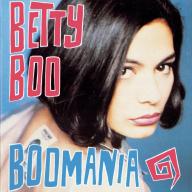Born Alison Moira Clarkson in Kensington, London, Betty Boo began her music career as a teenager, singing in the rap trio the She-Rockers, the duo Hit 'N' Run, and studying sound engineering at school. Originally dubbed Betty Boop because of her resemblance to the classic cartoon character, the half-Malaysian, half-Scottish singer became Betty Boo when lawyers representing Betty Boop objected to her use of the name. After signing with the Rhythm King label, Boo got her first taste of success guesting on the Beatmasters' 1989 single "Hey DJ I Can't Dance (To That Music You're Playing)," which reached number seven on the U.K. charts; in turn, the Beatmasters appeared on her 1990 single, "Doin' the Do," which also reached number seven due to the novelty of Boo's pop-rap approach and on the strength of the single's quirky, low-budget video. Boo's next single, "Where Are You Baby," featured an even more eye-catching clip and reached number three. Likewise, her full-length debut Boomania -- the majority of which Boo wrote and produced herself -- went platinum in the U.K. Boo went on to win the 1991 Brit Award for Best British Newcomer; that year, she also signed a deal with Warner/Sire. However, during an Australian concert, it was discovered she was lip-syncing to tapes. She canceled the rest of her tour and maintained a low profile until the release of her 1992 single "Let Me Take You There," which still managed to reach number 12 in the U.K. Its follow-up, "I'm on My Way," hit number 44. Boo's second album, Grrr! It's Betty Boo was made with producer John Coxon (later of Spring Heel Jack fame) and didn't match the commercial or critical success of its predecessor. Ultimately, the singer left Warner/Sire and the music industry itself, despite Madonna's efforts to sign Boo to Maverick Records.
She took a few years off to care for her mother, reappearing in 1997 as a backing vocalist on Kilo Ali's Organized Bass. A few years later, Boo found her niche in contemporary pop as a songwriter, penning the hit single "Pure and Simple" for the British teen pop sensation Hear'Say and collaborating with Bob and Chris Herbert, the impresarios behind the Spice Girls and 5ive. In 2006, she re-emerged briefly as half of the duo Wigwam with Blur's Alex James. They released one single, "Wigwam," then vanished. The next year, she released a dance-oriented single, "Take Off," with the group Jack Rokka, but her return again proved fleeting. She next appeared on the Feeling's 2011 album Together We Were Made, providing vocals on the song "Virtually Happy." Behind the scenes she continued to compose songs, writing for Sophie Ellis-Bextor and Paloma Faith, among others.
The singer only made rare public appearances over much of the next decade, including performing at England's PennFest in 2014 and Let’s Rock: The Retro Festival in 2021. Meanwhile, she entered the studio with producers Gavin Goldberg and Andy Wright, who had recently worked together on late-career albums by Simple Minds, Echo the Bunnymen, and Simply Red. The resulting Boomerang arrived on Betty Boo Records in October 2002, 30 years to the month after its predecessor. It featured duets with Chuck D and David Gray. ~ Heather Phares & Marcy Donelson, Rovi















